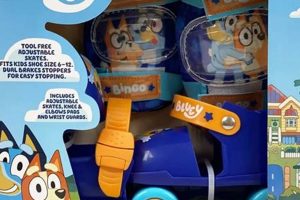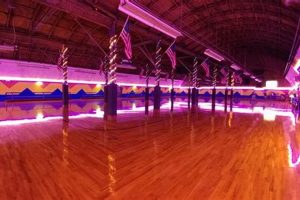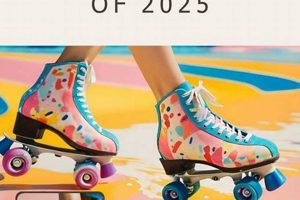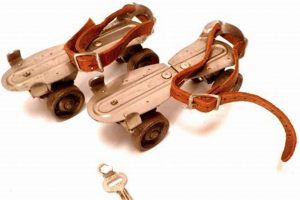The process of visually representing wheeled boots designed for gliding across surfaces requires careful attention to proportion and perspective. This artistic endeavor involves capturing the unique form of the boot, the chassis supporting the wheels, and the wheels themselves, ensuring a realistic and recognizable depiction of the recreational equipment.
Mastering the skill of illustrating these items allows for visual communication in various contexts, including instructional materials, design concepts, and artistic expression. The ability to accurately portray them contributes to clear and effective communication in skating-related industries and creative projects. Furthermore, studying the evolution of their design provides insight into technological advancements and cultural trends in recreational activities.
The following outlines fundamental techniques for achieving a compelling visual representation, starting with basic shapes, progressing to detailed components, and culminating in a polished final artwork.
Drawing Wheeled Footwear
Effective illustration hinges on understanding fundamental shapes and proportions. Focus on these initial elements to build a solid foundation for detailed rendering.
Tip 1: Begin with Basic Forms: Employ geometric shapesovals, rectangles, and cylindersto represent the major components of the skate. This provides a framework for accurate proportions and spatial relationships. For example, an oval could form the boot’s main body, while rectangles can represent the chassis.
Tip 2: Establish Perspective Early: Determine the viewing angle and establish a vanishing point. This dictates how lines converge and shapes diminish in size, creating a sense of depth and realism. Foreshortening of the boot and chassis is particularly important.
Tip 3: Focus on Wheel Placement and Alignment: Ensure that the wheels are correctly positioned relative to the chassis. Their alignment is critical for conveying a sense of stability and functionality. Remember to account for slight variations in wheel size or arrangement depending on the specific type of skate.
Tip 4: Define the Boot’s Structure: Add details to the boot, such as seams, laces, buckles, and padding. Observe real-world examples to accurately portray the boot’s construction and material texture. The boot’s shape often communicates the style and purpose of the skate.
Tip 5: Render Shadows and Highlights: Use shading to create depth and volume. Identify the light source and apply shadows accordingly. Highlights accentuate the contours of the skate and enhance its three-dimensionality. Subtle variations in tone can create a more realistic rendering.
Tip 6: Represent Material Texture: Differentiate between materials such as leather, plastic, and metal through varied rendering techniques. Cross-hatching, stippling, or smooth gradients can effectively convey these textural differences. The wheels, for instance, often have a smoother, more reflective surface than the boot.
Tip 7: Consider Dynamic Poses: For a more engaging illustration, depict the wheeled footwear in motion. This requires understanding how the skate interacts with the ground and the resulting shifts in balance and form. Angled wheels and trailing motion lines can effectively communicate movement.
By applying these techniques, the artist can create a compelling and accurate representation, capturing the essence and form of wheeled skating equipment.
With a firm grasp of these tips, the pursuit of visually representing wheeled footwear becomes a more manageable and rewarding endeavor. The following sections will explore advanced techniques and considerations.
1. Basic Shape Construction
Basic shape construction serves as the bedrock for visually representing wheeled skating equipment. This approach involves initially simplifying complex forms into fundamental geometric shapes, establishing a foundation for subsequent refinement and detail.
- Establishing Proportions
Geometric primitives spheres, cylinders, and rectangular prisms offer a framework for accurately capturing the relative dimensions. For instance, the boot’s overall volume can be approximated by a modified oval, while the chassis and wheels are represented by rectangles and circles, respectively. This preliminary step ensures that the final rendering adheres to realistic proportions.
- Defining Spatial Relationships
The arrangement of basic shapes dictates the spatial relationships between components. The placement of the wheel cylinders relative to the chassis rectangle defines the skate’s structural integrity. Overlapping shapes communicate depth, creating a sense of three-dimensionality essential for realistic portrayal. The precision in positioning these shapes directly impacts the perceived realism of the rendering.
- Simplifying Complex Curves
Wheeled skating boots often feature intricate curves and contours. Basic shapes offer a means of approximating these curves through a series of simplified lines and planes. For example, the ankle support’s curvature can be initially sketched as a modified trapezoid before refining the edges. This approach facilitates the management of complex forms, improving overall accuracy.
- Aiding Perspective Projection
Geometric forms simplify the application of perspective techniques. Converging lines can be accurately projected onto basic shapes, influencing their apparent size and orientation. This approach maintains consistency throughout the rendering, enhancing the overall sense of depth and realism. The foundational shapes serve as a reliable guide for applying perspective transformations.
By leveraging basic shape construction, the complexities of depicting wheeled skating footwear are mitigated, facilitating an accurate and visually compelling result. This foundational step serves as a crucial precursor to the addition of detail, shading, and textural elements.
2. Proportional Accuracy
Proportional accuracy is fundamental to the creation of a credible visual representation of wheeled skating equipment. Accurate proportions dictate the realism and believability of the illustration. Discrepancies in the relative size of components such as the boot, chassis, and wheels immediately detract from the overall effect, rendering the drawing unconvincing. The visual system is acutely sensitive to deviations from expected ratios; thus, maintaining proportional integrity is paramount.
The cause-and-effect relationship is direct: Accurate proportions result in a realistic depiction; inaccurate proportions lead to a distorted and unrealistic image. For example, if the wheels are drawn disproportionately large relative to the boot, the skate will appear unstable and impractical. Similarly, an undersized chassis will fail to convey the necessary structural support. Practical application involves careful measurement and comparison of real-world examples. Reference images serve as essential guides for establishing correct ratios and preventing unintended distortions. Consider the ratio of the boot height to wheel diameter or the chassis length to the boot length as critical benchmarks.
Achieving proportional accuracy is challenging, particularly when depicting equipment from oblique angles. Foreshortening and perspective can distort perceived proportions, requiring a nuanced understanding of spatial relationships. Overcoming this challenge involves employing techniques such as constructing a wireframe model before adding details, periodically checking proportions against reference images, and using measurement tools to verify accuracy. Understanding and applying these principles significantly contributes to the creation of credible and visually appealing illustrations of wheeled skating apparatus.
3. Perspective and Angles
The accurate portrayal of wheeled skating equipment fundamentally depends on the skillful application of perspective and the precise management of viewing angles. Perspective determines how objects recede into the distance and how their apparent size changes based on their spatial position relative to the observer. Viewing angle dictates the visible facets of the equipment and their corresponding distortions. Failure to accurately account for perspective and viewing angle results in a flat, unrealistic depiction devoid of depth and spatial coherence. A direct cause-and-effect relationship exists: Correct perspective and angles yield a three-dimensional, convincing illustration; incorrect application produces a distorted, improbable representation.
Perspective and angles are intrinsic components of visually representing wheeled skating equipment. The positioning of wheels, the curvature of the boot, and the orientation of the chassis are all governed by perspective principles. Consider, for instance, a skate viewed from a low angle. The wheels nearest the observer appear larger, while those farther away diminish in size, converging towards a vanishing point. The boot’s curvature is foreshortened, and the chassis appears compressed. Real-world examples, such as photographs or three-dimensional models, serve as essential guides for understanding and replicating these effects. Understanding the interplay between perspective and angle is crucial for conveying depth and realism. The ability to manipulate these elements allows the artist to control the viewer’s perception, creating a compelling visual narrative.
Mastering perspective and angles presents challenges, particularly for complex forms and dynamic poses. However, the practical significance of this understanding cannot be overstated. Accurate representation is essential for various applications, including product design, technical illustrations, and artistic renderings. A thorough grasp of these principles elevates the quality and impact of the visual representation, ultimately contributing to effective communication and artistic expression. Neglecting these fundamentals undermines the credibility and visual appeal of the final artwork.
4. Component Detailing
The fidelity of a visual representation of wheeled skating equipment hinges significantly on the accurate and thorough depiction of its constituent parts. Neglecting the nuances of each component undermines the overall realism and communicative efficacy of the illustration.
- Wheel Rendering
The wheels, critical for functionality, demand careful attention to detail. The texture of the wheel material (typically polyurethane), the precision of the bearings (often implied through subtle shading and highlighting), and the presence of any branding or markings contribute to the believability of the illustration. Inaccurate wheel rendering can lead to a depiction that appears flimsy or non-functional. For example, depicting the concave shape of the wheel profile or the slight rounding of the edges creates a realistic impression.
- Boot Structure Depiction
The boot’s construction, including seams, buckles, laces, and padding, conveys information about the style, purpose, and quality of the skate. Precisely illustrating the stitching patterns, the texture of the leather or synthetic materials, and the mechanics of the closure systems enhances the visual narrative. Deviations from accurate boot structure detract from the overall realism. Details such as scuff marks or wear patterns can further enhance authenticity.
- Chassis Representation
The chassis, providing structural support and wheel alignment, necessitates accurate depiction of its shape, material, and mounting hardware. The presence of adjustment mechanisms, the type of metal used (e.g., aluminum or steel), and the way the chassis connects to the boot all contribute to the technical accuracy of the illustration. An incorrectly rendered chassis can suggest a poorly designed or unstable skate. Subtle highlights can be used to convey the metallic sheen and structural integrity of the chassis.
- Hardware and Fasteners
Minute details such as rivets, screws, and bolts are crucial for conveying the construction and assembly of the wheeled skating equipment. The presence and accurate depiction of these fasteners reinforce the impression of a functional object. Omitting or misrepresenting this hardware undermines the realism and credibility of the illustration. For instance, rendering the subtle shadows cast by the screw heads or the gleam of polished rivets enhances the level of detail.
The successful integration of these detailed components directly impacts the perceived quality and realism of the illustration. This meticulous attention to detail enhances the ability to effectively convey information about the structure and design features. Furthermore, a thorough understanding and application of these component rendering techniques elevate the artistic merit of the representation.
5. Shading and Volume
The application of shading techniques is essential for conveying three-dimensionality in illustrations of wheeled skating apparatus. Without effective shading, drawings appear flat and lack visual depth, failing to accurately represent the form and structure of the equipment.
- Light Source Determination
The initial step involves establishing a consistent light source. This dictates the areas that receive direct illumination and those that fall into shadow. For example, with a light source positioned above and to the left, the upper left surfaces of the skate boot and wheels will be brighter, while the lower right portions will be darker. Accurate determination of the light source is critical for maintaining consistency in shading throughout the illustration.
- Shadow Mapping
Shadows delineate form and volume. Cast shadows indicate the relationship between different components, such as the boot and the chassis, while form shadows define the curvature and contours of individual surfaces. For instance, a soft gradient along the edge of the skate boot suggests its rounded form, while a sharper shadow beneath the chassis separates it from the wheels. Correct shadow mapping is vital for creating a realistic sense of depth.
- Highlight Placement
Highlights accentuate the points of maximum illumination and emphasize surface texture. Glossy surfaces, such as the wheels, exhibit concentrated highlights, whereas matte surfaces, like the boot leather, display more diffused highlights. Strategic placement of highlights enhances the material properties of the components. An intense highlight on the edge of a wheel, for example, suggests its smooth, reflective surface.
- Value Range Utilization
The effective use of a full value range, from light to dark, creates visual contrast and enhances the sense of volume. A limited value range results in a flat, washed-out appearance. Employing a gradual transition from light to dark values allows for subtle rendering of curves and contours. Careful manipulation of the value range can simulate the effects of ambient occlusion, further enhancing the three-dimensionality of the illustration.
The integration of these shading and volume techniques is integral to creating a visually compelling and realistic depiction of wheeled skating equipment. These techniques, when effectively employed, elevate the illustration from a flat representation to a three-dimensional rendering, accurately conveying the form, texture, and spatial relationships of the various components.
6. Material Representation
The accurate depiction of materials constitutes a critical component in the successful visual representation of wheeled skating apparatus. The aesthetic qualities and structural properties are intricately linked to their constituent materials. Representing these materials accurately is essential for conveying realism and facilitating clear visual communication. A direct cause-and-effect relationship exists: appropriate material representation contributes to a credible and informative illustration, while a failure to accurately portray materials leads to misinterpretations and diminished realism.
The selection and application of drawing techniques must correspond directly to the material being represented. For instance, the rendering of a polished aluminum chassis requires a different approach than the depiction of a textured leather boot. Aluminum may be represented with sharp highlights and reflected light, conveying its metallic sheen, while leather necessitates a more nuanced approach, potentially involving stippling or cross-hatching to simulate its textured surface. Furthermore, considerations extend to the replication of translucency in polyurethane wheels, requiring the careful application of gradients to simulate the transmission of light. Examples such as depicting the matte finish of nylon laces versus the glossy surface of a plastic buckle further illustrate the need for material-specific rendering techniques. Practical application also encompasses the accurate representation of material wear and tear, such as scuff marks on boots or abrasions on wheels, which can enhance realism.
Understanding the relationship between material properties and their visual representation is essential for effectively communicating the form, function, and quality of wheeled skating equipment. Accurately rendered materials contribute to a more convincing and informative illustration, enhancing the viewer’s comprehension and appreciation. Challenges associated with material representation, such as the replication of complex textures or the simulation of light interaction, require a dedicated approach and a thorough understanding of drawing techniques. Successful material representation elevates the overall quality and impact of the artwork, solidifying its value in various applications, including product design, advertising, and technical documentation.
Frequently Asked Questions
This section addresses common inquiries and misconceptions regarding the process of visually representing wheeled skating equipment.
Question 1: What are the essential initial steps when illustrating wheeled skating equipment?
The initial stage necessitates establishing fundamental shapes and proportions. Employing geometric primitives such as ovals, rectangles, and cylinders provides a foundational framework for accurate representation.
Question 2: How important is accurate perspective when drawing wheeled footwear?
Perspective is paramount. It dictates how objects recede into the distance and how their size diminishes relative to the viewer’s position, contributing significantly to the realism of the illustration.
Question 3: What techniques are crucial for rendering the wheels realistically?
The wheels require meticulous detailing, including the accurate depiction of material texture (typically polyurethane), the subtle representation of bearings, and any manufacturer’s markings. Attention to the concave shape and edge rounding is also essential.
Question 4: What role does shading play in the visual representation process?
Shading is instrumental in conveying depth and volume. Proper application of shadows and highlights delineates form, emphasizing contours and creating a three-dimensional effect.
Question 5: How does one effectively represent different materials, such as leather and metal, in an illustration?
Material representation requires tailored techniques. Metallic surfaces benefit from sharp highlights, while textured materials like leather are best depicted using stippling or cross-hatching. Accurate replication of material properties enhances realism.
Question 6: How critical is the depiction of small details such as rivets and screws?
Such seemingly minor details are of considerable importance. Their presence and accurate rendering reinforce the impression of a functional object, contributing substantially to the credibility and visual appeal of the representation.
A commitment to mastering these foundational aspects significantly improves the quality and effectiveness of visual representations of wheeled skating equipment. These principles are pivotal to achieving visually compelling results.
The subsequent segment will explore advanced artistic approaches to elevate the visual impact of your illustrations.
Conclusion
The exploration of “how to draw roller skates” has encompassed fundamental principles from basic shape construction and proportional accuracy to advanced techniques in perspective, component detailing, shading, and material representation. Mastery of these elements directly impacts the realism and communicative power of the visual depiction.
Continued refinement of these artistic skills enables effective communication in various fields, including product design, technical illustration, and creative expression. A sustained focus on accuracy and attention to detail remains paramount for achieving compelling and informative results. The visual representation of wheeled skating equipment serves as a testament to the intersection of artistic skill and technical understanding.







